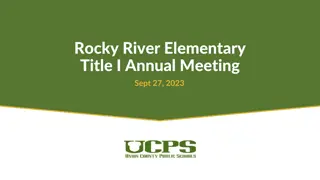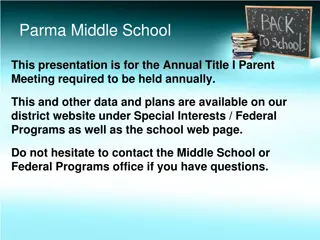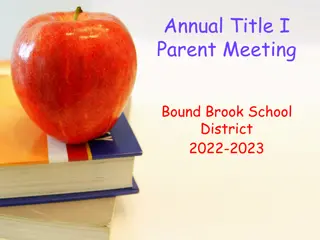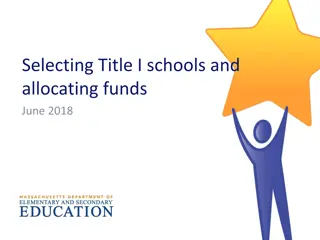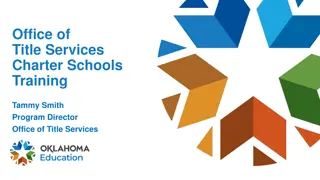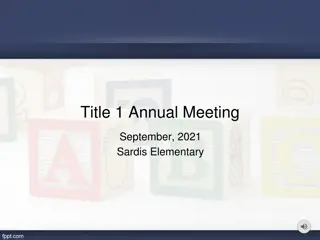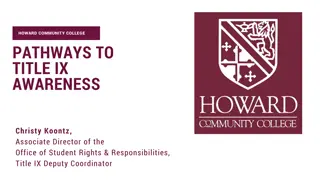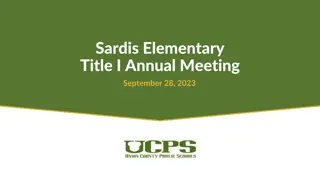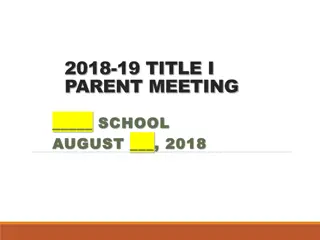Understanding Title I Program for School Success
Title I is a federal funding program that aims to help students meet academic standards, especially those from low-income families. It provides financial aid to schools, with a focus on improving academic achievement for all students. Assessments are conducted to track student progress, and funds are allocated based on the percentage of low-income students in each school. Stay informed about your child's assessment results and the overall use of Title I funds to ensure success in education.
Download Presentation

Please find below an Image/Link to download the presentation.
The content on the website is provided AS IS for your information and personal use only. It may not be sold, licensed, or shared on other websites without obtaining consent from the author. Download presentation by click this link. If you encounter any issues during the download, it is possible that the publisher has removed the file from their server.
E N D
Presentation Transcript
Title I Annual Meeting What Every Family Needs to Know! Date
Title I Program Purpose School participation
Purpose Title I provides federal funding to schools to help students meet the challenging State academic standards. Title I funds are targeted to schools with high numbers of children from low-income families. Title I is part of the Every Student Succeeds Act and provides about $15 billion per year in federal aid to local schools. More than 55,900 public schools receive Title I funds. Title I serves more than 26 million children. US Department of Education Title I, Part A Budget Tables
Schoolwide Basis - Funds used to serve all students in order to increase academic achievement. Participation Use of Title I funds Provide additional assistance to all students who experience difficulties in meeting the State s performance targets Improve school s entire educational program
Assessments Types Timeline for results
Assessments Required Assessments for Title I State Assessments Reading (ELA) and math annually for grades 3- 8 (Smarter Balanced Assessment Consortium SBAC) ELA and math in high school (District Common Finals and Nevada End of Course (EoC) Finals) Science in grades 5 and 8 (Nevada Science Assessments), and once in grades 9 or 10 (EoC Final) Other: Students who are English Learners (EL) have tests of English academic proficiency. Measure listening, speaking, reading, and writing skills in English (ACCESS for ELLs)
You will be notified of your child s assessment results. Timeline: Results Timeline State Assessments Grades 3-8 Fall after test is taken High school After District Common Assessments or EoC exams WIDA ACCESS Spring of current school year
Program Funds Allocated so schools with the most low income students get the most funding Allocated from the highest percentage down This chart is an example of four elementary schools and the percentage of students who receive free or reduced lunches.
Program Funds Amount of funds available for this year 168,563 Title I budget consists of: TNTP, DATA Coach, PLC PD Hours, Summer Academy, Benefits
Curriculum and Instruction Benchmark-ELA Envision-Math 2-5 Bridges-Math K-1 FOSS-Science K-5
Additional Parent Notification Requirements Parent And Family Engagement Policy, School-Parent Compact, Educator Qualifications, Additional Right-to- Know
District Policy Family Engagement Practices Governing Welcoming all families. Communicating effectively. Supporting student well-being and academic success. Speaking up for every child. Sharing power. Collaborating with community. Building the capacity of staff to engage families. Board Policy 5200
School Parent and Family Engagement Policy Our school has a written parent and family engagement policy, developed with and approved by parents. Spells out how parents will be engaged/ involved in a meaningful way. Lists required Title I meetings with parents and families For more details, please see the FACE Liaison or visit our school website. Describes Curriculum, Assessment, and Proficiency Levels Updated annually in the Spring
School-Parent Compact Every Title I school must have a School- Parent Compact, developed with and approved by parents. Compacts describe how the school and parents share responsibility for student achievement. Nevada law requires the use of the Educational Involvement Accords as the school-parent compact. Elementary schools - reviewed during parent/teacher conferences Middle and high schools completed through online registration
Educator Qualifications Teachers must meet Nevada certification requirements Paraprofessionals are highly qualified Timely notice given if a student has been taught for 4 or more weeks in a row by a teacher who does not meet the State certification requirements, i.e., long- term substitute
Parents Right-to-Know School Level Individual report card on your child s progress Information on State and local assessments Subject matter assessed Purpose of the assessment Right of parents to become involved in the school s programs and how to do so Volunteering Flexible meetings Monthly meetings Other
Parents Right-to-Know District Level District report card Overall student achievement Achievement by category Graduation rates District performance Gender Etc. Achievement by school State or District policy on student participation in mandated assessments English Learner (EL) placement
CSI-TSI-ATSI CSI COMPREHENSIVE SUPPORT AND IMPROVEMENT TSI TARGETED SUPPORT AND IMPROVEMENT ATSI ADDITIONAL TARGETED SUPPORT AND IMPROVEMENT Data from most recent NSPF and SPP/CIP. Progress toward goals The school has set goals in the areas of Mathematics improvement, ELA improvement and Community engagement. We saw growth in all areas and met our community engagement goal. SPP/CIP goals for current school year on Student Success, Adult Learning Culture, and Connectedness. Growth goals in Mathematics, ELA and Community Outreach. Data explaining systems in place, i.e., Formative and Needs Assessments, Climate Survey, etc. The school utilizes district common assessments, MAP, and SBAC Data CSI /TSI/ATSI designation. What that means The lowest performing five percent of schools based on an adjusted Nevada School Performance Framework (NSPF) index score All one-star schools on the Rising Stars List




